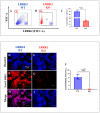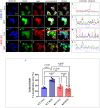LRRK2 Knockout Confers Resistance in HEK-293 Cells to Rotenone-Induced Oxidative Stress, Mitochondrial Damage, and Apoptosis
- PMID: 37445652
- PMCID: PMC10341561
- DOI: 10.3390/ijms241310474
LRRK2 Knockout Confers Resistance in HEK-293 Cells to Rotenone-Induced Oxidative Stress, Mitochondrial Damage, and Apoptosis
Abstract
Leucine-rich repeat kinase 2 (LRRK2) has been linked to dopaminergic neuronal vulnerability to oxidative stress (OS), mitochondrial impairment, and increased cell death in idiopathic and familial Parkinson's disease (PD). However, how exactly this kinase participates in the OS-mitochondria-apoptosis connection is still unknown. We used clustered regularly interspaced short palindromic repeats (CRISPR)/Cas9 LRRK2 knockout (KO) in the human embryonic kidney cell line 293 (HEK-293) to evaluate the cellular response to the mitochondrial inhibitor complex I rotenone (ROT), a well-known OS and cell death inducer. We report successful knockout of the LRRK2 gene in HEK-293 cells using CRISPR editing (ICE, approximately 60%) and flow cytometry (81%) analyses. We found that HEK-293 LRRK2 WT cells exposed to rotenone (ROT, 50 μM) resulted in a significant increase in intracellular reactive oxygen species (ROS, +7400%); oxidized DJ-1-Cys106-SO3 (+52%); phosphorylation of LRRK2 (+70%) and c-JUN (+171%); enhanced expression of tumor protein (TP53, +2000%), p53 upregulated modulator of apoptosis (PUMA, +1950%), and Parkin (PRKN, +22%); activation of caspase 3 (CASP3, +8000%), DNA fragmentation (+35%) and decreased mitochondrial membrane potential (ΔΨm, -58%) and PTEN induced putative kinase 1 (PINK1, -49%) when compared to untreated cells. The translocation of the cytoplasmic fission protein dynamin-related Protein 1 (DRP1) to mitochondria was also observed by colocalization with translocase of the outer membrane 20 (TOM20). Outstandingly, HEK-293 LRRK2 KO cells treated with ROT showed unaltered OS and apoptosis markers. We conclude that loss of LRRK2 causes HEK-293 to be resistant to ROT-induced OS, mitochondrial damage, and apoptosis in vitro. Our data support the hypothesis that LRRK2 acts as a proapoptotic kinase by regulating mitochondrial proteins (e.g., PRKN, PINK1, DRP1, and PUMA), transcription factors (e.g., c-JUN and TP53), and CASP3 in cells under stress conditions. Taken together, these observations suggest that LRRK2 is an important kinase in the pathogenesis of PD.
Keywords: Leucine-rich repeat kinase 2; apoptosis; clustered regularly interspaced short palindromic repeats; gene edition; human embryonic kidney cell line 293; knockout; oxidative stress; rotenone.
Conflict of interest statement
The authors declare no conflict of interest.
Figures










Similar articles
-
High Yield of Functional Dopamine-like Neurons Obtained in NeuroForsk 2.0 Medium to Study Acute and Chronic Rotenone Effects on Oxidative Stress, Autophagy, and Apoptosis.Int J Mol Sci. 2023 Oct 30;24(21):15744. doi: 10.3390/ijms242115744. Int J Mol Sci. 2023. PMID: 37958728 Free PMC article.
-
Rotenone Blocks the Glucocerebrosidase Enzyme and Induces the Accumulation of Lysosomes and Autophagolysosomes Independently of LRRK2 Kinase in HEK-293 Cells.Int J Mol Sci. 2023 Jun 24;24(13):10589. doi: 10.3390/ijms241310589. Int J Mol Sci. 2023. PMID: 37445771 Free PMC article.
-
Neuroprotective Effect of the LRRK2 Kinase Inhibitor PF-06447475 in Human Nerve-Like Differentiated Cells Exposed to Oxidative Stress Stimuli: Implications for Parkinson's Disease.Neurochem Res. 2016 Oct;41(10):2675-2692. doi: 10.1007/s11064-016-1982-1. Epub 2016 Jul 9. Neurochem Res. 2016. PMID: 27394417
-
Impaired mitochondrial dynamics and function in the pathogenesis of Parkinson's disease.Exp Neurol. 2009 Aug;218(2):235-46. doi: 10.1016/j.expneurol.2009.03.006. Epub 2009 Mar 18. Exp Neurol. 2009. PMID: 19303005 Review.
-
Exploring Parkinson-associated kinases for CRISPR/Cas9-based gene editing: beyond alpha-synuclein.Ageing Res Rev. 2023 Dec;92:102114. doi: 10.1016/j.arr.2023.102114. Epub 2023 Nov 2. Ageing Res Rev. 2023. PMID: 37924981 Review.
Cited by
-
The GBA1 K198E Variant Is Associated with Suppression of Glucocerebrosidase Activity, Autophagy Impairment, Oxidative Stress, Mitochondrial Damage, and Apoptosis in Skin Fibroblasts.Int J Mol Sci. 2024 Aug 25;25(17):9220. doi: 10.3390/ijms25179220. Int J Mol Sci. 2024. PMID: 39273169 Free PMC article.
-
Protective Effect of the LRRK2 Kinase Inhibition in Human Fibroblasts Bearing the Genetic Variant GBA1 K198E: Implications for Parkinson's Disease.Neuromolecular Med. 2025 May 21;27(1):42. doi: 10.1007/s12017-025-08864-y. Neuromolecular Med. 2025. PMID: 40397198 Free PMC article.
-
Neuroprotective Effects of the Nutraceutical Dehydrozingerone and Its C2-Symmetric Dimer in a Drosophila Model of Parkinson's Disease.Biomolecules. 2024 Feb 24;14(3):273. doi: 10.3390/biom14030273. Biomolecules. 2024. PMID: 38540694 Free PMC article.
-
The severity assessment of Parkinson's disease based on plasma inflammatory factors and third ventricle width by transcranial sonography.CNS Neurosci Ther. 2024 Mar;30(3):e14670. doi: 10.1111/cns.14670. CNS Neurosci Ther. 2024. PMID: 38459662 Free PMC article.
-
PF-06447475 Molecule Attenuates the Neuropathology of Familial Alzheimer's and Coexistent Parkinson's Disease Markers in PSEN1 I416T Dopaminergic-like Neurons.Molecules. 2025 May 2;30(9):2034. doi: 10.3390/molecules30092034. Molecules. 2025. PMID: 40363838 Free PMC article.
References
-
- Cornejo-Olivas M., Torres L., Velit-Salazar M.R., Inca-Martinez M., Mazzetti P., Cosentino C., Micheli F., Perandones C., Dieguez E., Raggio V., et al. Variable frequency of LRRK2 variants in the Latin American research consortium on the genetics of Parkinson’s disease (LARGE-PD), a case of ancestry. NPJ Park. Dis. 2017;3:19. doi: 10.1038/s41531-017-0020-6. - DOI - PMC - PubMed
MeSH terms
Substances
Grants and funding
LinkOut - more resources
Full Text Sources
Research Materials
Miscellaneous

